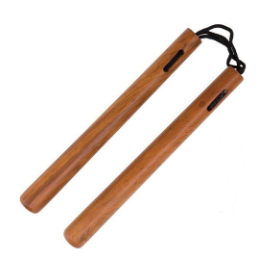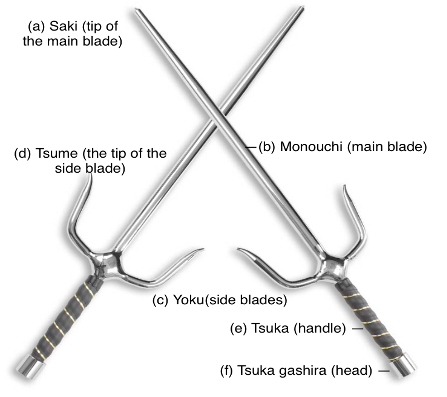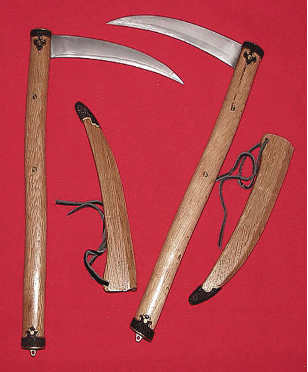OKINAWAN KOBUDO
Okinawan Kobudo is a Japanese term that can be translated as “old martial way of Okinawa”.
Okinawan kobudo refers to the weapon systems of Okinawan martial arts. These systems can have from one to as many as a dozen weapons in their curriculum, among the bo (six foot staff), sai (three-pronged truncheon), tonfa (handled club), kama (sickle), and nunchaku (two rope- or chain-connected sticks), but also the tekko (knuckledusters), tinbe-rochin (shield and spear), and surujin (weighted chain). Less common Okinawan weapons include the tambo (short stick), the hanbo (middle length staff) and the eku (boat oar of traditional Okinawan design).
Okinawan kobudo is distinguished from the general term kobudo, which refers to all Japanese martial arts that predate the Meiji Restoration.

BO STAFF
The basic purpose of the bo is increasing the force delivered in a strike, through leverage. The user’s relatively slight motion, effected at the point of handling the bo results in a faster, more forceful motion at the tip of the bo against the object or subject of the blow, thus enabling long-range and sweeping strikes. The bo may also be thrust at an opponent from a distance. The bo is a weapon mainly used for self-defense. The bo staff was traditionally used to balance buckets or baskets across ones shoulders. Typically, one would carry baskets of crops or buckets of water or milk, one at each end of the bo, that is balanced across the middle of the back at the shoulder blades. The bo remains a traditional farm work implement; yet, when the Okinawans were required to lay down their arms by the conquering Satsuma Samurai, they looked to their farming / household implements for their self-defence. The word “Bo” is merely the Japanese word for wooden staff weapons.
Bo Basics 1
Shushi No Kun
Kubo No Kun
Sakagawa Dai-ichi
Sakagawa Dai Ni
NUNCHAKU
The nunchaku, as we know it, comes from Okinawa (Uchina) which today is a prefecture of Japan. Okinawa lies almost midway between Taiwan and the Japanese “mainland”, and is the largest island in the Ryukyu (literally “rope”) archipelago, a 650 mile long chain of small islands between southern Japan and Taiwan. The most credible version of the origin of the nunchaku is that it descends from an Okinawan horse bit (muge). Initially the handles of the bit were curved. Later it was changed to the straight-handled weapon that we know today. Chinese nunchaku tend to be rounded, whereas Okinawan ones are octagonal.
Nunchaku Basics 1
Nunchaku Dai-ichi
Nunchaku Dai Ni


SAI
Various martial arts masters from Okinawa were famous for their skills in using Sai and they could skillfully throw them at an opponent. One of the founders of the Sai usage in Karate was the famous master Yasutsune (Anko) Itosu (1830 – 1891).
Kobudo practitioners often use heavier Sai in their training because the Sai serve to strengthen the muscles and to develop explosiveness and strength.
Learn how to name the individual parts of your Sai.
Sai Basics 1
Sai Dai-ichi
Sai Dai Ni
Sai Dai San
KAMA
The kama is a traditional Okinawan farming implement similar to a sickle used for reaping crops and is also employed as a weapon.The kama can be used either as a single or in pairs. Both the point and sharpened edge of the metal blade are called into use.
Okinawan kata suggest that it is also be used to block, trap and disarm an opponent’s weapon. The hard edge of the blade would be kept razor-sharp to enable efficient cutting of crops, though this is sometimes a cause of training accidents by unskilled wielders, for whom blunt training versions of the weapon are supplied.
Kama Basics 1
Kama Dai-ichi
Kama Dai Ni


TONFA
The tonfa is most commonly associated with the Okinawan martial arts. The tonfa can be used for blocking and striking and is great for developing strong wrists and hands, which is important for striking and blocking.
The tonfa may have originated as the handle of a millstone used for grinding grain. It is traditionally made from red oak, and can be gripped by the short perpendicular handle or by the longer main shaft. As with all Okinawan weapons, many of the forms are reflective of “empty hand” techniques. The tonfa is more readily recognized by its modern development in the form of the side-handle police baton, but many traditional tonfa techniques differ from side-handle baton techniques. For example, tonfa are often used in pairs, while side-handle batons generally are not
Tonfa Basics 1
Tonfa Dai-ichi

